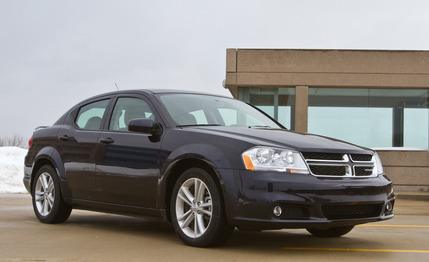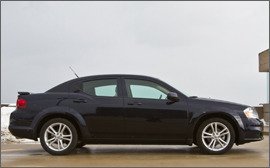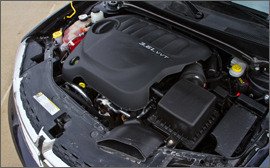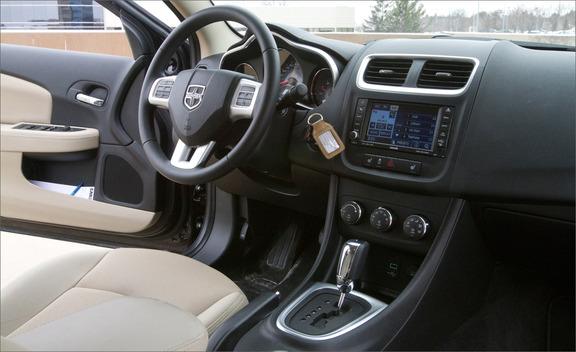 Short Take Road Test
Short Take Road Test
Dodge’s name for its mid-size sedan, borrowed from a World War II torpedo bomber—among other things—has always been a little mystifying. Avenging what? Adding zingy new designations for the various trim levels—Express (base), Mainstreet, Heat, Lux—didn’t clarify things much. Nevertheless, the revitalized Avenger makes a stronger case for itself than its predecessor, which has toiled in deserved anonymity since its introduction in 2008.
To be unkind, improving on the earlier Avenger was not one of the major techno challenges of the automotive age. In the Avenger’s most recent Car and Driver appearance, a four-cylinder SXT finished seventh of seven in a mid-size-sedan all-skate—not only last, but a distant last. Of 23 scoring categories, subjective and objective, it was tops in only one—lowest as-tested price—and its logbook was unusually rich in caustic test-crew commentary. One scribbler equated the sound of its engine with “walnuts in a Cuisinart.” Commenting on the hard interior plastics, another cautioned colleagues to “watch what your elbows bang into, because it’s gonna hurt.”

Now versus Then
But let us not dwell on the past. Thanks to a fresh lease on life, new management, and an infusion of creative energy from Fiat, Chrysler is busily revitalizing its product lineup, and the Avenger is one of the first beneficiaries. It’s not a total makeover, but it’s close. The wheelbase is unchanged at 108.9 inches, but the car is now 1.7 inches longer, an inch wider, and 0.5 inch lower, with static ride height reduced by 0.5 inch up front and 0.2 out back. It’s that good old “longer, lower, wider” mantra. Add nearly an inch to the track at the rear, and you have a more athletic stance, regardless of what happens with the sheetmetal.
As for that, the look—think small-scale Dodge Charger—is familiar. There are revisions to the lower front fascia, which incorporates new projector-beam fog lamps; minor tweaks to the going-away view; and a little refining of the trademark crosshair grille. More important, the all-new interior goes from strip-mall tacky to attractively contemporary, in terms of design and fit and finish. The color scheme in our test car was still reminiscent of midnight in a coal mine, but the instrument package looks decidedly more sophisticated, and the materials are first-rate, strikingly upscale from the hard plastics and unforgiving surfaces in the previous Avenger.

V-6 Punch
If the refurbished interior impresses potential buyers, a test drive could seal the deal, at least for those who strap themselves in behind the Avenger’s new V-6 option. Is a good car made better by a power increase? Not necessarily. Is it easier to like? Hey, you have to ask?
The Avenger’s previous 3.5-liter SOHC V-6 was tepid by mid-size-sedan standards: 235 hp, 232 lb-ft of torque. Its successor, the new Pentastar 3.6-liter V-6 with dual overhead cams, 24 valves, and variable valve timing, is rated at 283 hp and 260 lb-ft. Mated to Chrysler’s six-speed automatic, the 3.6 hustles the 3585-pound Avenger to 60 mph in 6.2 seconds and through the quarter-mile in 15.0 seconds at 91 mph. That’s good enough to put the Avenger among the quicker in its class. The other good news: improved fuel economy. The EPA rates the new V-6 at 19 mpg city and 29 highway versus 16/27 for the 3.5. We managed only 19, but your mileage will undoubtedly vary—upward.
Fancier Footwork
Like its powertrain, the Avenger’s chassis has been upgraded. It gets revised suspension bushings, higher-rate springs, retuned damping, and wider footprints: 225/50-18 Goodyear Eagle LS2 all-seasons on our test car. The variable-assist rack-and-pinion steering augments these updates. It’s quick—2.9 turns lock-to-lock—and tactile, contributing to a level of overall response that’s more decisive than the previous Avenger’s. Unfortunately, that rack gets bossed around by the Pentastar, with torque steer startling many of our drivers at their first stop-light launch.
The words “sports sedan” are a stretch here. But the Avenger Heat is certainly competent by contemporary standards, a family sedan with respectable crash-avoidance credentials—as well as respectable family-sedan ride quality. Allied with the latter, extensive sound-deadening work pays off with exceptionally quiet highway operation, a major comfort component.

Aside from the torque steer, the only dynamic debits are caveats in otherwise satisfactory areas: the brakes and the transmission. Although the “sports sedan” appellation does apply to the 169-foot stops we recorded from 70 to 0 mph—in a recent roundup including a couple of the Avenger’s leading competitors, the shortest stopper needed 12 more feet than the Dodge—we were less impressed by the squishy pedal. Not a good thing in a car with fewer than 4000 miles on the odo.
Shifts from the six-speed are reasonably prompt by torque-converter standards and are agreeably smooth. If the transmission seems to be in a hurry to get into top gear, that’s typical in an age of tightening fuel-economy standards. However, drivers hoping for a bit of sports-sedan flavor will be disappointed with this trans. Manual operation is via Chrysler’s old AutoStick shifter, which waggles side to side to effect up- and downshifts.
Value Points
The previous Avenger’s one strong suit was value—low price, lots of features. That’s still a strength, even with considerable development investment to recoup—not to mention government loans to pay off. The Avenger starts at $19,995. The Heat starts at $24,495 and adds the V-6 and six-speed auto, 18-inch aluminum wheels, fog lamps, a decklid spoiler, and a 30-gig hard-drive media center with a touchscreen. To that, this car added Blackberry Pearl paint (no BlackBerry Pearl phone included) for $295 and Bluetooth with Uconnect for $360, bringing the total to $25,150. That’s closer to the mid-size mainstream than the Avenger used to be. But so is the car.